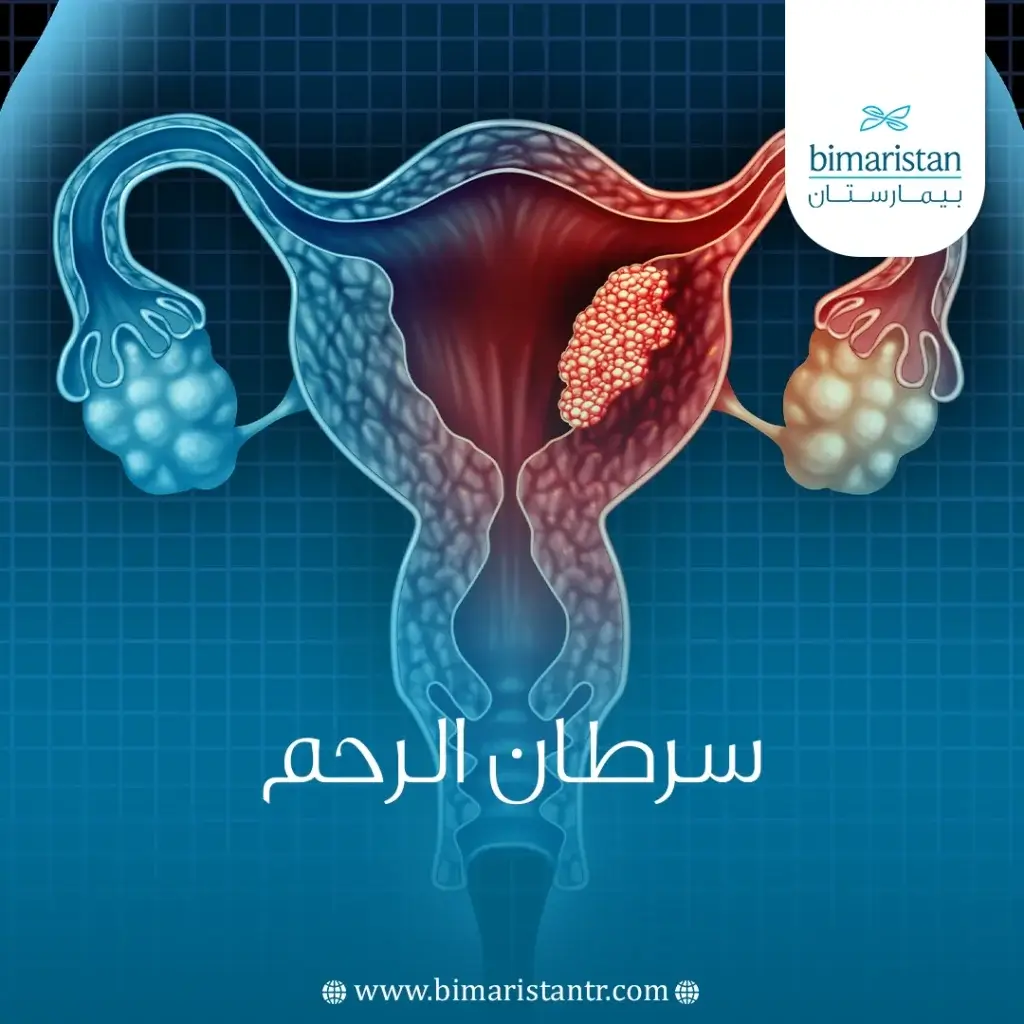سرطان الرحم من أكثر السرطانات شيوعاً في العالم، حيث يشكل ما يقارب 3.5% من جميع السرطانات، ولهذا أولت تركيا اهتماما كبيرا في تشخيص وعلاج هذا المرض.
دعونا نتفق أولاً على وجود فرق بين السرطان بالرحم (سرطان بطانة الرحم endometrium uterus tumor أو ساركوما الرحم) وسرطانات عنق الرحم cervical cancers، وسنذكر الفرق في هذا المقال، حيث كثيراً ما يخلط المرضى بين النوعين.
يشمل سرطان الرحم نوعين من السرطان: سرطان بطانة الرحم (أكثر شيوعاً) وساركوما الرحم، تشمل أعراض سرطان الرحم النزيف بين فترات الطمث أو بعد انقطاع الطمث. غالبًا ما يتطلب العلاج استئصال الرحم لإزالة الورم.
ما هو سرطان الرحم Uterine cancer؟
يعد سرطان اﻟﺮﺣﻢ مصطلح عام يصف كل أنواع سرطانات الرحم.
وغالباً ما ينشأ السرطان في البطانة الداخلية للرحم، ويعد هذا النوع أحد أكثر أنواع السرطانات النسائية شيوعاً.
يوجد نوع آخر من السرطانات الرحمية وذلك باختلاف مكان أو في طبقة نشأ فيها السرطان من الرحم، حيث تتطور ساركوما الرحم الخبيثة في عضلات جدار الرحم، كما ينشأ نوع آخر شائع جداً في الطبقة العضلية وهو الورم الليفي العضلي الرحمي السليم، إضافة لأنواع أخرى من الأورام التي تصيب الأنسجة الضامة المحيطة بالرحم إلا أنها نادرة جداً.
يسمى الجزء العلوي من الرحم بجسم الرحم، في الجزء السفلي يوجد عنق الرحم cervical الذي يربط الرحم بالمهبل، يشير مصطلح سرطان الرحم Uterine Cancer إلى سرطان في جسم الرحم، سرطان ﻋﻨﻖ الرحم هو نوع منفصل من السرطان.
لمحة عامة عن الرحم ووظيفته
إن الرحم هو الجزء من الجهاز التناسلي الأنثوي الذي يقوم كحاضنة لتعشيش البيضة الملقحة وتقسمها ونموها وتشكل الطفل وتنشأه حتى يصبح قادراً على العيش منفصلاً عن أمه.
يسمى الجزء العلوي من الرحم بجسم الرحم، أما الجزء السفلي فيدعى عنق الرحم Cervix الذي يربط الرحم بالمهبل (يجب التنويه إلى أن مصطلح سرطان الرحم Uterine Cancer يشير إلى سرطان في جسم الرحم، حيث أنَّ سرطان ﻋﻨﻖ الرحم هو نوع منفصل من السرطان).
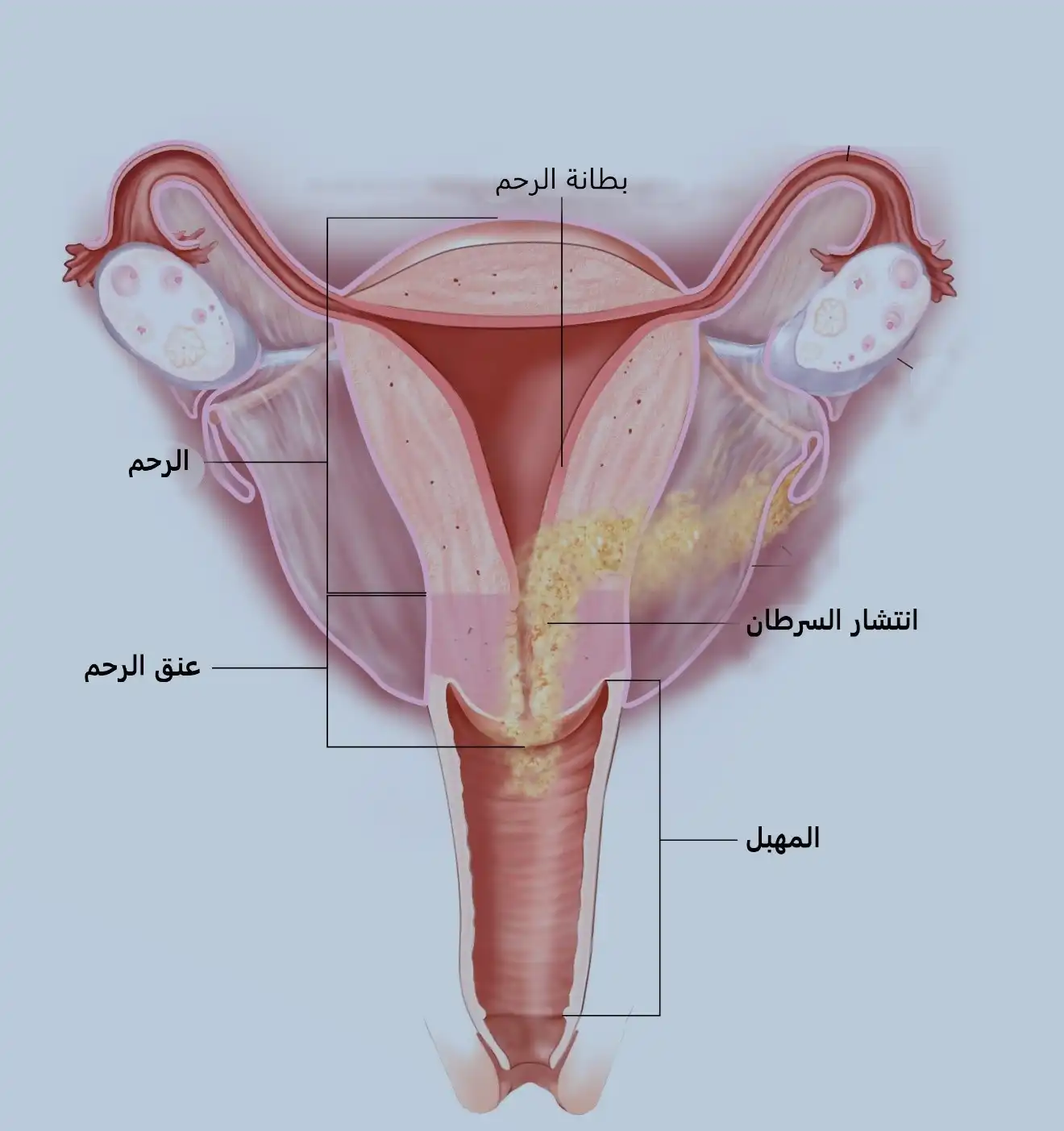
بطانة الرحم endometrium هي الطبقة الداخلية للرحم، تتغير سماكتها خلال الدورة الشهرية.
يتسبب هرمون الاستروجين في زيادة سماكة بطانة الرحم في حالة الحمل، إذا لم يحدث التلقيح والحمل، ينتج الجسم كمية أقل من الإستروجين والمزيد من البروجسترون، وهو هرمون مختلف في الوظيفة، وعندما يحدث ذلك، تسقط وتنكشط بطانة الرحم وهذا مايحدث في الدورات الطمثية.
وتتابع الدورة الرحمية التي تستمر 28 يوماً إلى أن يحدث الحمل فتتغير طبيعة الرحم ويتهيأ ليصبح قادراً على الوفاء بمتطلبات البيضة الملقحة المختلفة.
هل سرطان بطانة الرحم endometrium uterus tumor وسرطان الرحم متماثلان؟
يمكن أن يشير سرطان الرحم إلى سرطان بطانة الرحم أو ساركوما الرحم أو غيرها من أشكال السرطان النادرة التي تنشأ في الرحم.
ويعتبر الكثير من الناس مصطلحي “سرطان بطانة الرحم” و”سرطان الرحم” ذات الشيء، وذلك لأن سرطانات بطانة الرحم أكثر شيوعاً من السرطانات الأخرى التي تنشأ في الرحم.
اسباب سرطان الرحم وعوامل خطورته
الباحثون ليسوا متأكدين من السبب الدقيق للسرطان الرَّحمي، لسبب ما يحدث تغييرات في خلايا الرحم وتنمو الخلايا الطافرة وتتكاثر خارج نطاق السيطرة، وتشكل كتلة تسمى الورم.
هناك العديد من عوامل الخطر للإصابة بسرطان الرحم، يرتبط الكثير منها بالتوازن بين الإستروجين والبروجسترون، فالتعرض لهرمون الأستروجين بدون معاكسة بالبروجسترون وكل ما يؤدي لذلك يزيد خطر الإصابة بورم الرحم.
تشمل عوامل الخطر للإصابة بالسرطان ما يلي:
- العمر: مع تقدم النساء في السن، تزداد احتمالية الإصابة بسرطان الرحم. وينشأ معظم سرطانات الرحم بعد سن الخمسين.
- نمط الحياة والنظام الغذائي: النظام الغذائي الغني بالدهون الحيوانية يمكن أن يزيد من خطر الإصابة بعدة أنواع من السرطانات، بما في ذلك سرطان بطانة الرحم. الأطعمة الدهنية غنية أيضاً بالسعرات الحرارية، مما قد يؤدي إلى السمنة حيث أن الوزن الزائد هو عامل خطر مهم للإصابة بسرطان الرحم.
- تاريخ العائلة: ينقل بعض الآباء طفرات جينية (تغييرات) لسرطان القولون والمستقيم الوراثي غير السلائلي (HNPCC)، حيث تزيد هذه الحالة الموروثة من خطر الإصابة بمجموعة من السرطانات، بما في ذلك سرطان بطانة الرحم.
- داء السكري: يرتبط هذا المرض غالباً بالسمنة (والتي بدورها تزيد من نسبة حدوث السرطان)، لكن تشير بعض الدراسات إلى وجود علاقة مباشرة بين مرض السكري وسرطان الرحم.
- السمنة (زيادة وزن الجسم): تتحول بعض الهرمونات إلى هرمون الاستروجين عن طريق الأنسجة الدهنية، مما يزيد من خطر الإصابة بسرطان الرحم، أي أنه كلما زادت كمية الأنسجة الدهنية، زادت تغيرات توازن الهرمونات بالجسم.
- أمراض المبيض: النساء المصابات بأورام معينة في المبيض لديهن مستويات عالية من هرمون الاستروجين وانخفاض مستويات البروجسترون، يمكن لهذه التغيرات الهرمونية أن تسبب زيادة بخطر الإصابة بسرطان الرحم.
- الحيض المبكر: إذا بدأت الدورة الشهرية قبل سن 12 عاماً، فقد يزداد خطر الإصابة بسرطان الرحم، وذلك لأن الرحم يتعرض للإستروجين لسنوات عديدة.
- سن اليأس المتأخر: وبالمثل، إذا حدث انقطاع الطمث بعد سن الخمسين، تزداد المخاطر أيضاً، يتعرض الرحم للإستروجين لفترة أطول.
- فترة الحيض الطويلة: قد يكون عدد سنوات الحيض أكثر أهمية من عمرك عندما بدأت الدورة الشهرية أو انتهت.
- عدم الحمل: تتعرض النساء غير الحوامل لخطر أكبر بسبب زيادة التعرض للإستروجين
كما يمكن أن يكون العلاجات لحالات أخرى من الأسباب المهمة التي تزيد من نسبة الإصابة بسرطان الرحم من هذه العلاجات نذكر:
- العلاج الإشعاعي للحوض (بين البطن والساقين): العلاج الإشعاعي لعلاج السرطانات الأخرى يمكن أن يتلف الحمض النووي للخلايا، قد يؤدي هذا الضرر إلى زيادة خطر الإصابة بنوع ثاني من السرطانات.
- العلاج ببدائل الإستروجين (ERT): يتلقى بعض الأشخاص العلاج بالإستروجين للمساعدة في تخفيف أعراض انقطاع الطمث، تواجه النساء اللائي يأخذون ال ERT بدون البروجسترون خطرا أكبر للإصابة بسرطان الرحم.
- استخدام عقار تاموكسيفين: قد يتلقى الناس هذا الدواء لعلاج سرطان الثدي، يعمل مثل هرمون الاستروجين في الرحم ويمكن أن يزيد من خطر الإصابة بسرطان الرحم.
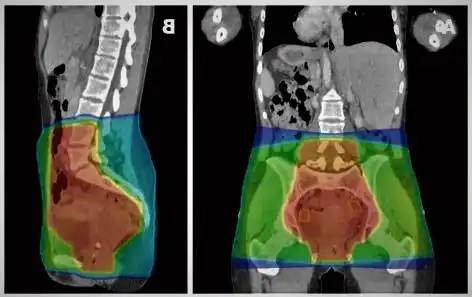
ماهي اعراض سرطان الرحم؟
قد تكون أعراض سرطان الرحم غير نوعية وتتشابه مع أعراض تظهر بسبب حالات مرضية أخرى تؤثر على الأعضاء التناسلية.
تشمل أعراض سرطان بطانة الرحم أو ساركوما الرحم ما يلي:
- نزيف مهبلي بين فترات الحيض عند النساء قبل سن انقطاع الطمث.
- نزيف مهبلي عند النساء بعد سن اليأس، ولو بكمية قليلة.
- ألم أسفل البطن أو تقلصات في الحوض أسفل البطن مباشرة.
- إفرازات مهبلية بيضاء أو شفافة عند النساء بعد سن اليأس.
- نزيف مهبلي طويل أو شديد أو متكرر لدى النساء الأكبر من 40 عاماً.
إذا لاحظت ألماً غير عادي أو نزيفاً، فيمكنك التواصل معنا، حيث سيوجهك مركز بيمارستان إلى أفضل الأطباء وسيقومون بتقديم التشخيص الدقيق مهم حتى تتمكن من الحصول على العلاج المناسب.
اعراض سرطان الرحم المبكرة
تكون اعراض سرطان الرحم المبكر غير نوعية بشكل كاف، لذلك يجب على المريضة أو مقدم الرعاية الصحية لها الانتباه لهذه الأعراض وإجراء الاستقصاءات اللازمة.
كيف يتم تشخيص سرطان بطانة الرحم؟
قد يقوم طبيبك بإجراء واحد أو أكثر من الاختبارات لتأكيد تشخيص سرطان الرحم، ومن هذه الإجراءات:
الفحوصات المخبرية
مقايسة CA-125 عبارة عن سحب عينة دم نقيس فيها كمية الواسم البروتيني CA-125، يمكن أن تشير كمية معينة من CA-125 إلى وجود سرطان في الجسم (وخاصةً في الرحم أو المبيضين أو قناتي فالوب).
اختبارات التصوير
تلتقط الأشعة المقطعية سلسلة من الصور التفصيلية لداخل الجسم.
تستخدم فحوصات التصوير بالرنين المغناطيسي موجات الراديو ومغناطيساً قوياً لإنشاء الصور.
تقوم الموجات فوق الصوتية عبر المهبل بإدخال مسبار خاص (جهاز ناعم ومستدير) ﻣﻦ داخل المهبل للحصول على صور للرحم.
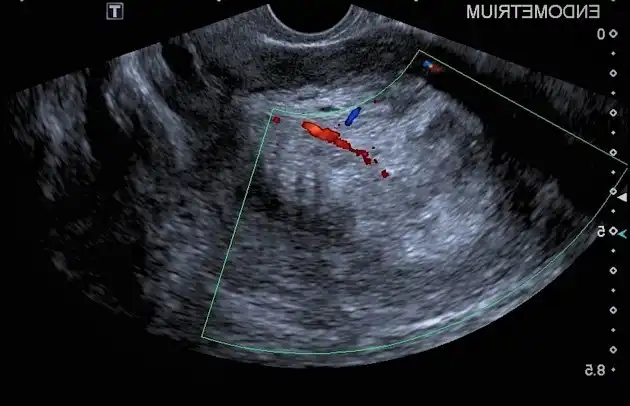
اختبارات أخرى
إجراء خزعة جراحية:
نقوم بخزعة بطانة الرحم بواسطة أنبوب رفيع ومرن عبر عنق الرحم (فتحة المهبل) وفي الرحم، حيث يقوم الطبيب بإزالة جزء من النسيج المُبطن للرحم.
تنظير الرحم:
يُدخل منظار الرحم وهو عبارة عن أنبوب رفيع طويل، عبر المهبل وعنق الرحم للوصول إلى الرحم، توفر هذه الأداة الدقيقة المزودة بضوء وكاميرا صوراً تفصيلية للرحم.
التوسيع والكشط (D&C):
هو إجراء أكثر تعقيداً لإزالة أنسجة الرحم، يحدث في غرفة العمليات.
يقوم طبيبك بإرسال العينة إلى المختبر حيث يقوم أخصائي علم الأمراض هنالك بفحص الأنسجة للتأكد من وجود سرطان.
كيف يتم علاج سرطان بطانة الرحم في تركيا؟
يحتاج معظم المصابين بسرطان بطانة الرحم إلى الجراحة. تعتمد خطة التدبير والعلاج الخاصة بك على نوع السرطان و الحالات الصحية العامة للمرضى. تشمل العلاجات الأخرى التي قد تتناولها ما يلي:
- العلاج الكيميائي: الذي يستخدم عقاقير قوية لتدمير الخلايا السرطانية.
- العلاج الإشعاعي: والذي يرسل حزم إشعاعية موجهة لتدمير الخلايا السرطانية.
- العلاج بالهرمونات: والذي يعطي الهرمونات المثبطة لنمو السرطان أو يمنع الهرمونات المحفزة للورم من التأثير.
- العلاج المناعي: الذي يساعد جهاز المناعة على محاربة السرطان، وإن هذا العلاج (بالإضافة للعلاج الموجه) هو الملاذ الأخير في حال فشل العلاجات غير الجراحية الأخرى وكانت الجراحة ليست خياراً مطروحا لسبب من الأسباب، حيث أثبتت الدراسات أن العلاج الموجه عند هؤلاء المرضى قد أحدث تحسن لديهم.
- العلاج الموجه: والذي يستخدم الأدوية لاستهداف خلايا سرطانية معينة لمنعها من التكاثر.
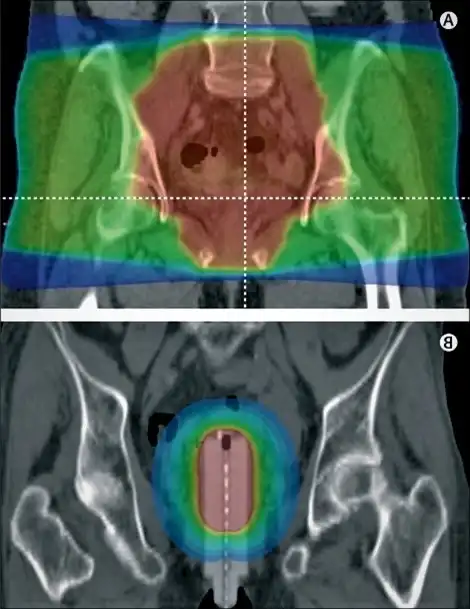
يواصل الباحثون دراسة المزيد من الطرق لعلاج سرطان بطانة الرحم.
ما نوع جراحة سرطان بطانة الرحم التي قد تجرى للمريض؟
عادة ما تكون الجراحة هي العلاج الرئيسي لسرطان بطانة الرحمن هناك ثلاثة أنواع من إجراءات استئصال الرحم:
- استئصال الرحم الكلي عبر البطن: يقوم الجراح بعمل شق (قطع) في البطن للوصول إلى الرحم وإزالته.
- استئصال الرحم المهبلي: يقوم الجراح بإزالة الرحم عن طريق المهبل.
- استئصال الرحم الجذري: إذا انتشر السرطان إلى عنق الرحم، فقد تحتاجين إلى استئصال الرحم الجذري، يقوم الجراح بإزالة الرحم والأنسجة المجاورة للرحم، يقوم الجراح أيضاً بإزالة الجزء العلوي من المهبل بجوار عنق الرحم.
أثناء استئصال الرحم، غالباً ما يقوم الجراحون بإجراء عمليتين أخريين أيضاً وهما:
- استئصال البوق والمبيض الثنائي (BSO) لإزالة المبيضين وقناتي فالوب: يحتاج معظم الناس إلى هذه الخطوة الإضافية للتأكد من إزالة جميع أنواع السرطان.
- إزالة العقد اللمفاوية وإرسالها للتشريح المرضي ومعرفة ما إذا كان السرطان قد انتشر.
كيف يتم علاج ساركوما الرحم في تركيا؟
في كثير من الأحيان، يستخدم الجراحون إجراءً واحداً لتشخيص ساركوما الرحم و تحديد المرحلة (وصف شدتها) وعلاجها.
خيارات العلاج مثل تلك الخاصة بسرطان بطانة الرحم، تخضع معظم النساء لعملية استئصال الرحم، بالإضافة إلى BSO لإزالة المبيضين وقناتي فالوب.
هل يمكن الوقاية من سرطان بطانة الرحم؟
في معظم الأوقات، لا يمكنك منع حدوث سرطان الرحم. ولكن يمكنك اتخاذ خطوات لتقليل المخاطر:
- السيطرة على مرض السكري.
- الحفاظ على وزن صحي.
- تغيير نمط الحياة وتناول الطعام الجيد والحصول على قسط كافٍ من النوم وممارسة الرياضة.
- الابتعاد عن التدخين.
- في حال كانت المريضة من مرضى الخطورة العالية، يجب عليها مراجعة الطبيب بشكل دوري.
بالنهاية، نجد أن سرطان بطانة الرحم من أكثر أنواع السرطانات التي تصيب الجهاز التناسلي للمرأة شيوعاً، ويمكن علاجه جراحياً أو كيميائياً، وخاصة إذا شخص بشكل باكر، ويجب على المرأة أن تعتني بصحتها وأن تبتعد عن نمط الحياة السيء حماية لنفسها ولمن حولها.
المصادر:
